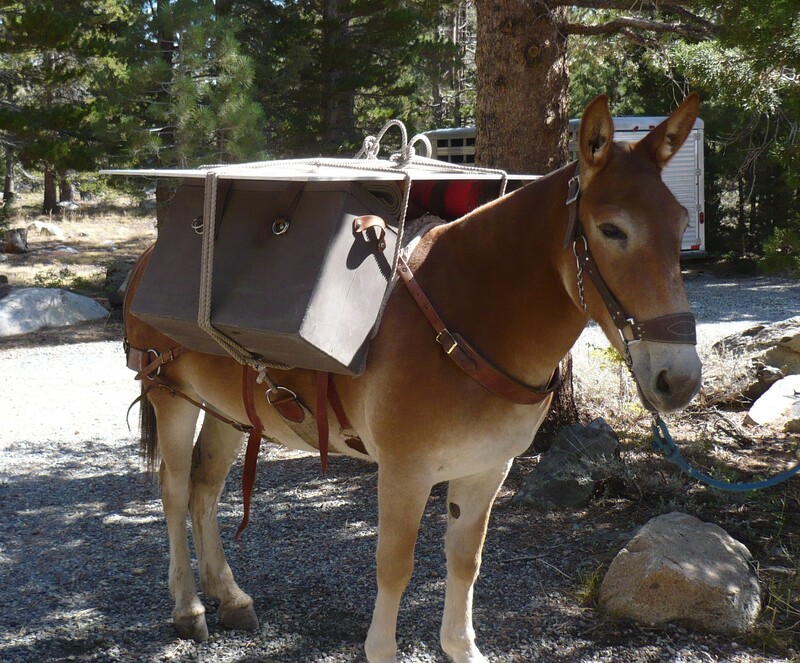|
I love the versatility of mules. Not only can they pull my wagon and farm implements but they can also carry my hunting camp into the mountains then pack the venison out. Let me tell you about an interesting project that seems to combine the skills of both disciplines of mulemanship.
The water flume and head gate at East Lake in the Hoover Wilderness had been in need of repair for years. The water from this lake is used by several cattle ranches in the Bridgeport area so a joint effort was made to repair it. As it is in a wilderness you can only travel by foot or horseback which made transporting materials to the job site a bit of a challenge. Most cowboys are good packers and every ranch has a pack saddle and panniers in the tack room to be used mainly for packing salt out to the range cattle. This chore was usually assigned to a green colt which helped round him out to a well seasoned ranch horse. However, the materials for this job were somewhat unusual so I was asked to come up with some ideas that didn’t require a helicopter and possibly utilize my more experienced mules. The first item was the gate itself which was a large aluminum plate measuring 4 feet by 4 ½ feet and 3/8 inch thick weighing 75 pounds. This seemed simple; I could hang my large pack boxes high on the sawbuck and bridge the plate across then tie a box hitch to hold it all together. The next items were two pieces of 4 inch channel iron 8 feet long. Okay, we’ll hang those on each side of a mule angling over her neck in the same manner you would carry a couple of fence post. The last item was the real challenge, a threaded screw rod used for opening and closing the head gate when a large wheel is turned. This stainless steel rod measured 1 ¼ in diameter by 14 feet long and weighed 80 pounds. Too long to pack on one mule so I made a couple of platforms to sit on the sawbucks then attached a swivel devise to the platforms and then welded a cradle, made of horse shoes, to the swivels. My plan was to bridge the screw rod between two mules. The swivel devises would allow them to navigate the sharp turns with the rod spanding between them as long as they worked together. I’ll admit this was not an original idea but I’ve only heard about this method and never actually seen it done. I chose Maude and Suzy; the two mules I felt would be most tolerant for this strange assignment. We felt confident after a short practice and were ready to go but then the whole project got put on hold for two years. When the call finally came that all was a go for our little packing job there was no time for another practice. I was also informed that there will be a couple more items than we first talked about, two 8 foot 4x4’s. No problem I’ll just take another mule and hang these 4x4’s just like the channel iron. We all met at the trailhead and all the ranches were well represented with Top hands. We loaded the first two items as planned but the 4x4’s turned out to be 4x6x10 foot timbers. I scratched my head, we could load these like fence post if we had an 18 hand mule otherwise they will drag the ground like a Travois. What we ended up doing was lashing the timbers to either side of the screw rod and loaded the whole thing on the two swivel mules. The timbers with the rod were all three guys could lift onto the mules. It seemed awfully top heavy to me but there was no way to counter balance it now. I will tell you that I wasn’t as confident as before but up the trail we went and to our delight the two mules learned to work together real quick. Remember that these are Draft mules that are accustomed to working together on a wagon tongue and other farm implements so this just came natural to them. Fortunately we had some minor switchbacks on the trail to practice on before we came to the “Chute” which is a series of steep switchbacks only 15 yards apart. If you have ever tried to carry a large couch up a stairway then turn through a narrow doorway then you might have some idea what these two mules were accomplishing. As the lead mule makes the turn around the switchback she is now traveling almost 180 degrees in the opposite direction of the second mule with the rod and timbers suspended between them. Maude did get pushed into the rock wall at the first switchback but Suzy learned to slow her pace allowing Maude time to recover and continue on up the trail. Maude in turn had to slow down long enough for Suzy to make the turn behind her. They performed this maneuver a dozen times on the climb up the Chute. It was several miles up the canyon to East Lake and we only had to stop a couple of times to make some minor adjustments. All the materials made it to the dam intact and were off loaded to the relief of Maude and Suzy. What a great feeling of success, one that I’m sure is shared with my long eared friends. By Rick Edney
0 Comments
Leave a Reply. |
AuthorAmerican Mule Museum: Telling the story of How the West Was Built – One Mule at a Time Archives
January 2021
Categories |




